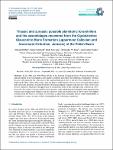Triassic and Jurassic possible planktonic foraminifera and the assemblages recovered from the Ogrodzieniec Glauconitic Marls Formation (uppermost Callovian and lowermost Oxfordian, Jurassic) of the Polish Basin
| dc.contributor.author | Hart, MB | |
| dc.contributor.author | Gebhardt, H | |
| dc.contributor.author | Setoyama, E | |
| dc.contributor.author | Smart, CW | |
| dc.contributor.author | Tyszka, J | |
| dc.date.accessioned | 2024-01-24T11:53:09Z | |
| dc.date.available | 2024-01-24T11:53:09Z | |
| dc.date.issued | 2023-12-08 | |
| dc.identifier.issn | 0262-821X | |
| dc.identifier.issn | 2041-4978 | |
| dc.identifier.uri | https://pearl.plymouth.ac.uk/handle/10026.1/21954 | |
| dc.description.abstract |
Abstract. In the 1960s and 1970s Werner Fuchs of the Austrian Geological Survey (Vienna) described a significant number of new foraminiferal taxa that he considered ancestral to the planktonic foraminifera. All these taxa are well-curated in the collections of the Austrian Geological Survey and have been studied by one of us (Malcolm B. Hart). Some of these taxa, from the Triassic and lowermost Jurassic strata of Austria and northern Italy, are poorly preserved, possibly the result of having an original aragonitic wall structure. None of these taxa possess characters which give the appearance of a planktonic mode of life, although some of them (e.g. Oberhauserella, Praegubkinella) may well have been ancestral to the holoplanktonic foraminifera that appeared in the Toarcian and younger strata. Other taxa in the collections of the Austrian Geological Survey (part of GeoSphere Austria), from the Jurassic of Poland, are preserved as glauconitic steinkerns and are either unidentifiable as foraminifera or suspect in terms of their stratigraphical and evolutionary significance. | |
| dc.format.extent | 277-290 | |
| dc.language | en | |
| dc.publisher | Copernicus GmbH | |
| dc.subject | 3709 Physical Geography and Environmental Geoscience | |
| dc.subject | 31 Biological Sciences | |
| dc.subject | 3103 Ecology | |
| dc.subject | 3104 Evolutionary Biology | |
| dc.subject | 37 Earth Sciences | |
| dc.subject | 3705 Geology | |
| dc.title | Triassic and Jurassic possible planktonic foraminifera and the assemblages recovered from the Ogrodzieniec Glauconitic Marls Formation (uppermost Callovian and lowermost Oxfordian, Jurassic) of the Polish Basin | |
| dc.type | journal-article | |
| dc.type | Article | |
| plymouth.issue | 2 | |
| plymouth.volume | 42 | |
| plymouth.publication-status | Published online | |
| plymouth.journal | Journal of Micropalaeontology | |
| dc.identifier.doi | 10.5194/jm-42-277-2023 | |
| plymouth.organisational-group | |Plymouth | |
| plymouth.organisational-group | |Plymouth|Research Groups | |
| plymouth.organisational-group | |Plymouth|Faculty of Science and Engineering | |
| plymouth.organisational-group | |Plymouth|Faculty of Science and Engineering|School of Geography, Earth and Environmental Sciences | |
| plymouth.organisational-group | |Plymouth|Research Groups|Marine Institute | |
| plymouth.organisational-group | |Plymouth|REF 2021 Researchers by UoA | |
| plymouth.organisational-group | |Plymouth|Users by role | |
| plymouth.organisational-group | |Plymouth|Users by role|Academics | |
| plymouth.organisational-group | |Plymouth|REF 2021 Researchers by UoA|UoA07 Earth Systems and Environmental Sciences | |
| plymouth.organisational-group | |Plymouth|REF 2028 Researchers by UoA | |
| plymouth.organisational-group | |Plymouth|REF 2028 Researchers by UoA|UoA07 Earth Systems and Environmental Sciences | |
| dcterms.dateAccepted | 2023-10-12 | |
| dc.date.updated | 2024-01-24T11:53:08Z | |
| dc.rights.embargodate | 2024-1-27 | |
| dc.identifier.eissn | 2041-4978 | |
| rioxxterms.versionofrecord | 10.5194/jm-42-277-2023 |


